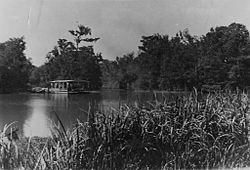| Bayou Pierre | |
|---|---|
 Ferry in French Settlement, Louisiana on Bayou Pierre, ca. 1940–43 Ferry in French Settlement, Louisiana on Bayou Pierre, ca. 1940–43 | |
| Bayou Pierre | |
| Location | |
| Country | United States |
| State | Louisiana |
| Parishes | |
| Physical characteristics | |
| Source | |
| • location | Shreveport, Louisiana |
| • coordinates | 32°28′15″N 93°44′16″W / 32.4709°N 93.7377°W / 32.4709; -93.7377 |
| Mouth | |
| • location | Red River |
| • coordinates | 32°21′03″N 93°39′00″W / 32.3507°N 93.6499°W / 32.3507; -93.6499 |
| Discharge | |
| • location | Clarence, Louisiana |
| Basin features | |
| River system | Red River |
| Cities | |
Bayou Pierre is a partially man-made bayou and ancient course of the Red River in Louisiana, United States. It is a tributary of the Red River originating from an ancient bend of the Red River at Coate's Bluff (Wright Island) in Shreveport, LA (now blocked off by a levee to prevent the Red River from flooding into Bayou Pierre) and merging west from the town of Clarence, Louisiana. The upper part of Bayou Pierre within Shreveport city limits is now a concrete drainage ditch at the bottom of the former watercourse, and provides street drainage for much of eastern Shreveport before the concrete drainage ditch section ends south of LA 526.
During the era of the Great Red River Raft that blocked much of the Red River and diverted water into alternate waterways such as Bayou Pierre, Bayou Pierre was a navigable waterway that served as an alternate water route connecting the downriver plantations with Shreveport. History books tell of steamships docking at the current site of Betty Virginia Park in Shreveport, LA in order to bypass the raft and serve the plantations downriver.
Wildlife Management Area
In Frierson, Louisiana, there is a wildlife area for Bayou Pierre and marshes. In this land, there are 2,799 acres. The land is owned by the Louisiana Department of Wildlife and Fisheries (LDWF). They allow hunting, trapping, and ornithology. Also, camping is allowed at specific areas.
History
In the early 1990s, farmers drained the area and destroyed the ecosystem. However, the farming attempts backfired assumedly because of poor soil absorption. The farmers gave up and deeded the land to the LDWF.
Ecosystem
The ecosystem is known to contain white-tailed deer, raccoons, sandpipers, dove, rabbits, and many types of waterfowl. In the winter, sandpipers flock to the area. Additionally, the area floods occasionally due to poor soil absorption.
Fort Selden
Fort Selden was situated at the junction of Bayou Pierre and Red River in Natchitoches Parish, Louisiana.
References
- US Army Corps of Engineers (September 1950). "Geology of the Lower Red River". Technical Memorandums (TECHNICAL MEMORANDUM NO. 3-319): 20.
- UL Coleman Companies. "History of Coates' Bluff at Wright Island". UL Coleman Companies. Retrieved 25 July 2024.
- "Google Maps". Google Maps. Retrieved 5 December 2021.
- Trudeau History Tours. "During the steamboat era". Retrieved 25 July 2024.
- "Bayou Pierre Wildlife Management Area". Louisiana Land Conservation Assistance Network. Retrieved 5 December 2021.
- ^ "Bayou Pierre". Louisiana Department of Wildlife and Fisheries. Retrieved 5 December 2021.
- Frazer, Robert W. (1972). Forts of the West. University of Oklahoma Press, pp. 63-64.